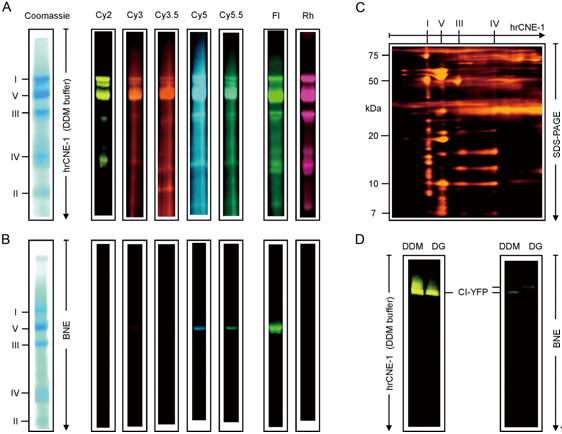Mempro™ Native PAGE Services
With the advanced Mempro™ nanodiscs analysis platform established for a long time, Creative Biostructure can offer tailored Mempro™ native PAGE services for nanodiscs analysis. Our experienced scientists are confident in providing high-quality native PAGE services to meet all your demands.
Native PAGE is a method developed to separate polypeptides via charge to mass ratio, which uses the identical inconsecutive chloride and glycine ion fronts as SDS-PAGE to generate moving boundaries that stack. To perform this technique, a non-reducing and non-denaturing sample buffer is necessary in which proteins remain in their secondary structure and native charge density. Hence, multiple bands enable to be seen from the camshot of the native PAGE gel if the target protein is in a protein complex in the sample. In native PAGE electrophoresis, the major positions of proteins present an acidic or basic pl (isoelectric point), which force them to move towards the polar. In addition, there are two basic forms of native PAGE, blue native PAGE (BN-PAGE) and clear native PAGE, which are both widely used in the nanodiscs analysis.
 Figure 1. Fluorescent signal intensities in hrCNE and BNE gels. (Wittig, I. 2007)
Figure 1. Fluorescent signal intensities in hrCNE and BNE gels. (Wittig, I. 2007)
- Blue Native PAGE (BN-PAGE)
BN-PAGE was designed for the separation of mitochondrial membrane proteins and compound in the mass about 10 kDa to 10 MDa and it is an inexpensive and convenient technique. It is applied for the one-step separation of microgram a lot of membrane protein complexes from biological membranes and tissue homogenates and total cell. There are many others applications of BN-PAGE, for example, measuring native masses and oligomerized states, clinical diagnostics of human mitochondrial disorders, determine physiological protein–protein interactions, researching neurotransmitter assembly and nanodiscs analysis. For example, a SecYEG complex incorporated into nanodiscs was analyzed by BN-PAGE and the purified SecYEG complex moves as a population of monomer and dimmer. - Clear Native PAGE (CN-PAGE)
Clear-native PAGE (CN-PAGE), initially named colorless native PAGE, has been described after the advancement of BN-PAGE. It was most applied as a reference to BN-PAGE for the sake of illustrating the essential role of the negatively charged Coomassie-dye for the preferred BN-PAGE. Because no charged dye is used in CN-PAGE, the electrophoretic mobility of proteins in that turns on the intrinsic charge of the proteins. The move distance relies on the protein intrinsic charge, and on the pore size of the gradient gel. The sensitivity of CN-PAGE is at the fewest 10-times higher than BN-gels in-gel assay.
Besides nanodiscs analysis, Creative Biostructure also provides other various Mempro™ nanodiscs analysis service. Please feel free to contact us for a detailed quote.
References:
Wittig, I. (2006). “Blue native PAGE”. Nature Protocols, 1, 418-428.
Wittig, I. (2007). “High resolution clear native electrophoresis for in-gel functional assays and fluorescence studies of membrane protein complexes”. Molecular & Cellular Proteomics, 6(7), 1215-1225
Kikuchi, S. (2006). “Characterization of the preprotein translocon at the outer envelope membrane of chloroplasts by blue native PAGE”. Plant and cell physiology, 47(3), 363-371.